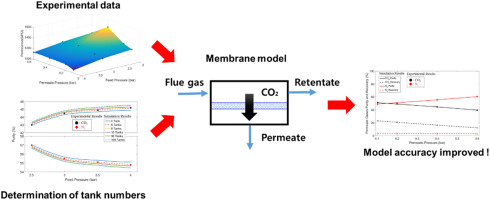当前位置:
X-MOL 学术
›
J. Membr. Sci.
›
论文详情
Our official English website, www.x-mol.net, welcomes your
feedback! (Note: you will need to create a separate account there.)
Membrane separation process for CO 2 capture from mixed gases using TR and XTR hollow fiber membranes: Process modeling and experiments
Journal of Membrane Science ( IF 8.4 ) Pub Date : 2017-11-01 , DOI: 10.1016/j.memsci.2017.07.003 Sunghoon Lee , Michael Binns , Jung Hyun Lee , Jong-Ho Moon , Jeong-gu Yeo , Yeong-Koo Yeo , Young Moo Lee , Jin-Kuk Kim
Journal of Membrane Science ( IF 8.4 ) Pub Date : 2017-11-01 , DOI: 10.1016/j.memsci.2017.07.003 Sunghoon Lee , Michael Binns , Jung Hyun Lee , Jong-Ho Moon , Jeong-gu Yeo , Yeong-Koo Yeo , Young Moo Lee , Jin-Kuk Kim

|
Abstract Numerous membrane models have been developed and tested for the simulation of membrane processes. However, these models are often either simplified or only validated with a narrow range of experimental data. For the model-based process design of membrane systems it is necessary to have a validated and accurate model which is accurate for the range of possible operating conditions under consideration. Hence, in this study a modeling framework is developed for hollow fiber membranes which can be adjusted systematically to accurately predict the performance of a given membrane. Mixed-gas (CO2/O2/N2 and CO2/N2) separation experiments are carried out over a range of different feed conditions to evaluate membrane performance and to provide reliable measurements of gas permeance. In particular the feed pressure (1–4 bar), permeate pressure (0.1–0.5 bar) and feed flow rates (0.096–0.4 N m3/h) are varied in these experiments (the ranges specified in brackets). Interpolation of these measured permeance allows for the accurate prediction of membrane performance at any conditions inside the measured range. A tanks-in-series modeling approach is employed here where the number of tanks (used to represent the membrane behavior in a numerical formulation) can be adjusted to calibrate and fit the membrane model to experimental results. For the membranes tested in this study it is found that using a relatively small number of tanks both minimizes the difference between model and experimental results and reduces the numerical complexity in the membrane model.
中文翻译:

使用 TR 和 XTR 中空纤维膜从混合气体中捕获 CO 2 的膜分离过程:过程建模和实验
摘要 许多膜模型已被开发和测试用于模拟膜过程。然而,这些模型通常要么被简化,要么仅使用范围狭窄的实验数据进行验证。对于基于模型的膜系统工艺设计,必须有一个经过验证的准确模型,该模型对于所考虑的可能操作条件的范围是准确的。因此,在这项研究中,为中空纤维膜开发了一个建模框架,可以系统地调整该框架以准确预测给定膜的性能。混合气体(CO2/O2/N2 和 CO2/N2)分离实验在一系列不同的进料条件下进行,以评估膜性能并提供可靠的气体渗透性测量。特别是进料压力 (1–4 bar)、渗透压力 (0. 1–0.5 bar) 和进料流速 (0.096–0.4 N m3/h) 在这些实验中是不同的(括号中指定的范围)。这些测量的渗透性的内插允许在测量范围内的任何条件下准确预测膜性能。此处采用串联罐的建模方法,其中罐的数量(用于表示数值公式中的膜行为)可以调整以校准膜模型并使膜模型适合实验结果。对于本研究中测试的膜,发现使用相对较少数量的罐既可以最大限度地减少模型和实验结果之间的差异,又可以降低膜模型的数值复杂性。这些测量的渗透性的内插允许在测量范围内的任何条件下准确预测膜性能。此处采用串联罐的建模方法,其中罐的数量(用于表示数值公式中的膜行为)可以调整以校准膜模型并使膜模型适合实验结果。对于本研究中测试的膜,发现使用相对较少数量的罐既可以最大限度地减少模型和实验结果之间的差异,又可以降低膜模型的数值复杂性。这些测量的渗透性的内插允许在测量范围内的任何条件下准确预测膜性能。此处采用串联罐的建模方法,其中罐的数量(用于表示数值公式中的膜行为)可以调整以校准膜模型并使膜模型适合实验结果。对于本研究中测试的膜,发现使用相对较少数量的罐既可以最大限度地减少模型和实验结果之间的差异,又可以降低膜模型的数值复杂性。此处采用串联罐的建模方法,其中罐的数量(用于表示数值公式中的膜行为)可以调整以校准膜模型并使膜模型适合实验结果。对于本研究中测试的膜,发现使用相对较少数量的罐既可以最大限度地减少模型和实验结果之间的差异,又可以降低膜模型的数值复杂性。此处采用串联罐的建模方法,其中罐的数量(用于表示数值公式中的膜行为)可以调整以校准膜模型并使膜模型适合实验结果。对于本研究中测试的膜,发现使用相对较少数量的罐既可以最大限度地减少模型和实验结果之间的差异,又可以降低膜模型的数值复杂性。
更新日期:2017-11-01
中文翻译:

使用 TR 和 XTR 中空纤维膜从混合气体中捕获 CO 2 的膜分离过程:过程建模和实验
摘要 许多膜模型已被开发和测试用于模拟膜过程。然而,这些模型通常要么被简化,要么仅使用范围狭窄的实验数据进行验证。对于基于模型的膜系统工艺设计,必须有一个经过验证的准确模型,该模型对于所考虑的可能操作条件的范围是准确的。因此,在这项研究中,为中空纤维膜开发了一个建模框架,可以系统地调整该框架以准确预测给定膜的性能。混合气体(CO2/O2/N2 和 CO2/N2)分离实验在一系列不同的进料条件下进行,以评估膜性能并提供可靠的气体渗透性测量。特别是进料压力 (1–4 bar)、渗透压力 (0. 1–0.5 bar) 和进料流速 (0.096–0.4 N m3/h) 在这些实验中是不同的(括号中指定的范围)。这些测量的渗透性的内插允许在测量范围内的任何条件下准确预测膜性能。此处采用串联罐的建模方法,其中罐的数量(用于表示数值公式中的膜行为)可以调整以校准膜模型并使膜模型适合实验结果。对于本研究中测试的膜,发现使用相对较少数量的罐既可以最大限度地减少模型和实验结果之间的差异,又可以降低膜模型的数值复杂性。这些测量的渗透性的内插允许在测量范围内的任何条件下准确预测膜性能。此处采用串联罐的建模方法,其中罐的数量(用于表示数值公式中的膜行为)可以调整以校准膜模型并使膜模型适合实验结果。对于本研究中测试的膜,发现使用相对较少数量的罐既可以最大限度地减少模型和实验结果之间的差异,又可以降低膜模型的数值复杂性。这些测量的渗透性的内插允许在测量范围内的任何条件下准确预测膜性能。此处采用串联罐的建模方法,其中罐的数量(用于表示数值公式中的膜行为)可以调整以校准膜模型并使膜模型适合实验结果。对于本研究中测试的膜,发现使用相对较少数量的罐既可以最大限度地减少模型和实验结果之间的差异,又可以降低膜模型的数值复杂性。此处采用串联罐的建模方法,其中罐的数量(用于表示数值公式中的膜行为)可以调整以校准膜模型并使膜模型适合实验结果。对于本研究中测试的膜,发现使用相对较少数量的罐既可以最大限度地减少模型和实验结果之间的差异,又可以降低膜模型的数值复杂性。此处采用串联罐的建模方法,其中罐的数量(用于表示数值公式中的膜行为)可以调整以校准膜模型并使膜模型适合实验结果。对于本研究中测试的膜,发现使用相对较少数量的罐既可以最大限度地减少模型和实验结果之间的差异,又可以降低膜模型的数值复杂性。















































 京公网安备 11010802027423号
京公网安备 11010802027423号